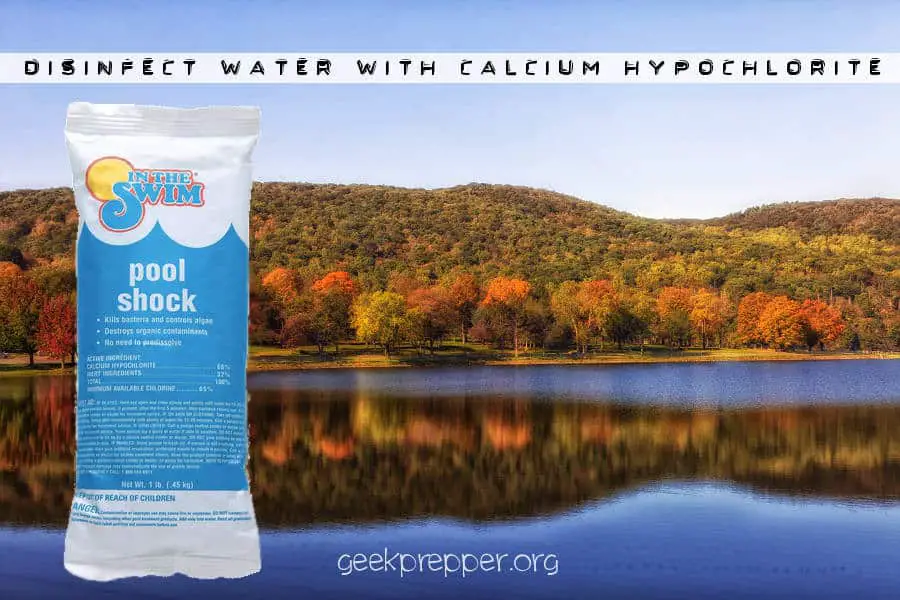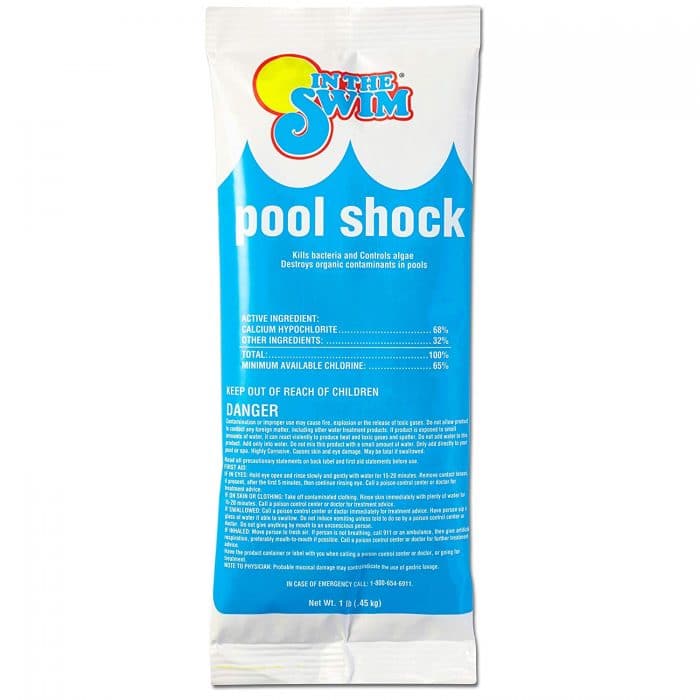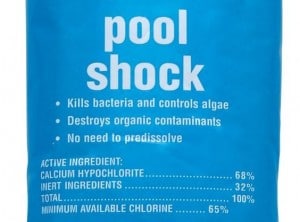You know bleach to make safe drinking water, but bleach only has a shelf life of about 6 months.
You can use the active ingredient from bleach and disinfect water with Calcium Hypochlorite.

Disinfect Water with Calcium Hypochlorite
Boiling your Water is the easiest way to make it safe. Bleach (ONLY Calcium Hypochlorite bleach) can also be used to make safe drinking water, but bleach has a shelf life of less than 2 years.
You can use the active ingredient from bleach and disinfect water with Calcium Hypochlorite.
Calcium Hypochlorite is a granular (or powder) product typically used to chlorinate swimming pools. It is also known as “Pool Shock”.
We’ll use the Dry Calcium Hypochlorite to make our own bleach solution, to purify water. Once you add water to the Calcium hypochlorite the clock is ticking on its effective life-span, just like regular bleach. Store the granules dry for long-term storage.
Making the Chlorine Bleach Solution
First, we need to make our bleach solution. This bleach solution is NOT drinkable, we are using it to treat the water we do want to drink. DO NOT DRINK THE ORIGINAL Chlorine (BLEACH) SOLUTION!
Create the Chlorine (Bleach) Solution (used to treat the drinking water…not for drinking directly)
- To make a stock of chlorine solution (do not drink this!) dissolve 1 heaping teaspoon (about one-quarter of an ounce) of high-test (78%) granular calcium hypochlorite for every two gallons (eight liters) of water.
Disinfecting Water for DRINKING
- To disinfect water add one part of the chlorine solution to 100 parts water to be treated.
- Let the mixture sit for at least one-half hour before drinking.
- To remove any objectionable chlorine odor, aerate the water.
If the water is cloudy with suspended particles:
- First filter the water as best you can (a t-shirt, bandana, shemagh or other fabric will work)
- Double the amount of bleach you add to the water.
- Stir it well.
- Let the mixture stand for a half-hour before drinking.
One lb. bag of this stuff will make around 128 gallons of bleach, which should allow you to treat about 12800 gallons of water (1:100 ratio). 10,000 gallons of drinking water, is roughly enough for a family of four for six or seven years at a gallon per day per person!
Do not mix the dry granular calcium hypochlorite until you are ready to treat water since once it is made into a liquid solution it will begin to degrade and will eventually become useless as a disinfecting agent. This also means you should make your treated drinking water in small batches, for example, enough for a few weeks at a time at most.
When selecting your calcium hypochlorite, ensure that it does NOT contain any water clarifiers or anti-algae agents.
A bonus for using calcium hypochlorite to disinfect water is that a little goes a very long way. A 1-pound bag of calcium hypochlorite in granular form typically costs only a few US dollars and can be obtained on Amazon.com, or at your local pool supply company. This amount will treat up to 10,000 gallons of drinking water, which is enough for a family of four for between 7 to 7 years, at a gallon per day per person!
The Pros and Cons of Using Calcium Hypochlorite in Disinfecting Water
Calcium Hypochlorite is a cost-effective choice when it comes to water sanitation. You only need a really small amount of it to disinfect a large amount of water. A pound of granular calcium hypochlorite can disinfect and treat about 10,000 gallons of water.
This chemical is also quite easy to use. It’s actually stable and may need less equipment when used. Plus, it’s also easy to transport.
Another plus point is its length of storage. You can actually keep your calcium hypochlorite for a long time without worrying about diminishing its ability to disinfect water.
Take note that this doesn’t mean that the chemical doesn’t lose its effectiveness. Even though it doesn’t technically expire, it can still lose some of its potency over time.
The main con of using calcium hypochlorite is storage. You need to make sure that it doesn’t come in contact with moisture or heat. You should also remember to keep it in a spot in your home that’s always dry and well-ventilated.
A Word of Caution

Although calcium hypochlorite is an effective agent for disinfecting water, it’s still a highly reactive material. With that said, you should always be careful when handling and even storing it. If it comes in contact with something that it’s not compatible with, it’s likely to trigger a violent reaction.
For storage, it’s a good idea to keep calcium hypochlorite as far away as possible to any fuel source. It may ignite with oil, paper or wood. The reaction it can cause with fuels can be quite violent.
Now, if a fire does break out, don’t use a fire extinguisher. It may contain chemicals that can cause bigger damages and problems. To take out the fire, just use lots of water.
As always verify the products and measurements to be sure this info is safe and correct. I take no responsibility if you can’t measure properly, buy the wrong product or just screw this up. Your life is yours, so do your homework! When done properly you can safely Disinfect Water with Calcium Hypochlorite.




